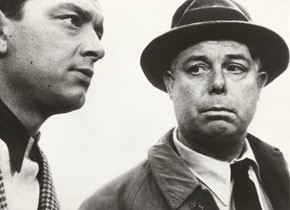Jean Renoir
The Complete Works
December 1 2006 to January 8, 2007
A large-scale retrospective will wrap up the year 2006: the Austrian Film Museum pays homage to the artist who with more justification than any other can be called "The Mozart of Cinema".
With his inimitable mixture of lightness and depth, his world of ideas which is firmly rooted in the traditions of French Enlightenment, his subtle, cheerful and sometimes bitter portrayal of relations between the sexes, and with his moving stories about transitoriness and death, Jean Renoir's works are a key to cinema as a whole.
Jean Renoir (1894-1979), the son of the Impressionist painter Pierre-Auguste Renoir, achieved a unique kind of freedom in his work, both in his aesthetic strategies and in his method of collective development which characterizes many of his best films. In the end, he was also able to free himself from the constraints of the market; only one of his films (the pacifist classic La Grande Illusion, 1937) was a real box office success, but thanks to the extraordinary freshness which his works have maintained long beyond their date of origin, Renoir's significance has been repeatedly confirmed.
Of particular importance was the pioneering role which was bestowed upon him by the budding filmmakers of the Nouvelle Vague: the idea of filmic authorship, the politique des auteurs, was developed on the basis of Renoir's films and their blend of complexity and spontaneity. Alain Resnais' statement concerning Renoir's La Règle du jeu (1939) epitomizes this view: "It’s the most overwhelming experience I have ever had in the cinema."
The reception of Renoir's works can be assessed most clearly in the context of this film's fate: released shortly before the outbreak of World War II, it was received with hostility and created a scandal; in the intervening years, however, it has come to be seen as one of the most outstanding masterpieces in the history of film.
The second decisive element in Renoir's oeuvre is his fascination for reality. His early film La Chienne (1931) was shot in the streets, using direct sound in a radical fashion; in his ground-breaking "neo-realist” film Toni (1935), he adapted a "story from the local pages of the newspaper, which I hardly changed at all when bringing it to the screen". The so-called Poetic Realism in prewar French cinema is also strongly defined through his films (such as La Bête Humaine or La Nuit du carrefour).
But it would still be a misrepresentation to categorize Renoir as a simple realist. His career spans a major part of cinema’s development in the 20th century, from the 1920s avant-garde with its explicitly artificial experiments up to the Modernism of the 1950s and 60s, which he accompanied in his own personal fashion. It is all one continuous creative process which demonstrates Renoir's true project: an aesthetic which does justice to the (hidden) diversity of reality. "My most profound goal is to look for fairy-tale elements in the utter banality of everyday life."
Typically enough, it is precisely the radiant Impressionism in Renoir’s invocations of nature that displays the most intoxicating opulence – in Une partie de campagne (1936), shot in brilliant black and white, and in Le Déjeuner sur l'herbe (1959), saturated with colour. The interplay of life and art, of truth and artificiality which Renoir strove for, was summed up by Anna Magnani (playing an actress, of course) in the definitive reflection on this theme, The Golden Coach (1953): "Where does theatre start? Where does life stop?"
Over the course of 46 years and nearly as many films, Jean Renoir weighed these questions and always endeavoured to "discover humans". Starting with his first (co-)directorial work Une vie sans joie (1924), which arose out of pure enthusiasm for cinema (and above all for Erich von Stroheim, who was later to become Renoir's friend and collaborator), this continued right through to the serenity of his final film, Le Petit Théâtre de Jean Renoir (1970).
The history of cinema can be found between those two films. Renoir’s works include sumptuous "film-novels" (Nana, based on Zola, 1926) and clever miniatures (La Petite Marchande d'allumettes, based on H.C. Andersen, 1928); a series of brilliant genre pieces and film adaptations in the 1930s, followed by increasingly critical interventions in the socio-political arena and an alliance with the French Popular Front which culminated in La Vie est à nous and Le Crime de Monsieur Lange.
Fleeing Fascism, Renoir went to Hollywood, where for nearly a decade he attempted to reconcile his working methods with the limitations of the American film industry, wringing at least two masterpieces out of the system in the process: This Land is Mine (1943) and The Southerner (1945).
His path back home and towards his great late works first led him to India, where he made a film whose absolutely relaxed mood, nonchalantly intoxicating Technicolor photography and, above all, humility and equanimity sum up Jean Renoir's genius. The River (1951), a film about life by the river and about the flow of the world, is also a true masterpiece in an art form whose highest goal is the pursuit of constant movement, in a never-ending struggle against stagnation.


